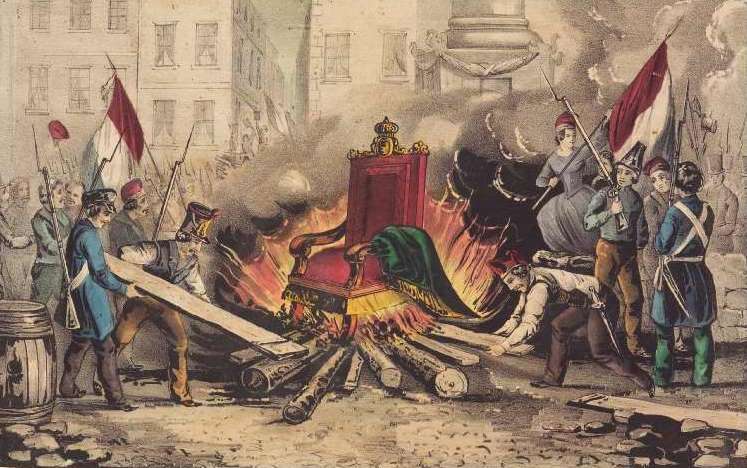
Drawing of the destruction an equestrian monument of Louis XV and the plaques around the column during the French Revolution.
Paris in 1792 is no longer what it was in 1789. In 1789, the old French society was still brilliant. The past endured beside the present. Neither names nor escutcheons, neither liveries nor places at court, had been suppressed. The aristocracy and the Revolution lived face to face. In 1792, the scene has changed. The Paris of the nobility is no longer in Paris, but at Coblentz. The Faubourg Saint-Germain is like a desert. Since June, 1790, armorial bearings have been taken down. The blazons of ancient houses have been broken and thrown into the gutters. No more display, no more liveries, no more carriages with coats-of-arms on their panels. Titles and manorial names are done away with. The Duke de Brissac is called M. Cossé ; the Duke de Caraman, M. Riquet; the Duke d’Aiguillon, M. Vignerot. The Almanach royal of 1792 mentions not a single court appointment.

Destruction of the statue of Louis XIV, Place Vendôme, August 1792. This act, pulling down the original statue of Louis XIV that had stood in place for nearly 100 years, was one of many during the Revolution that set in place the idea of destroying the monuments.
In 1789, it was still an exceptional thing for the nobility to emigrate. In 1792, it is the rule. Nearly every salon was open in 1789. In 1792, they are nearly all closed; those of the magistrates and the great capitalists as well as those of the aristocracy. Etiquette is still observed at the Tuileries, but there is no question of fetes; no balls, no concerts, none of that elegance and animation which once made the court a rendezvous of pleasures. In 1789, illusions, dreams, a naive expectation of the age of gold, were to be found everywhere. In 1792, eclogues and pastoral poetry are beginning to go out of fashion. The diapason of hatred is pitched higher. Already there is powder and a smell of blood in the air.
A general instinct forebodes that France and Europe are on the verge of a terrible duel. On both sides passions have touched their culminating point. Distrust and uneasiness are universal. Every day the despotism of the clubs becomes more threatening. The Jacobins do not reign yet, but they govern. Deputies who, if left to their own impulses, would vote on the conservative side, pronounce for the Revolution solely through fear of the demagogues. In 1789, the religious sentiment still retained power among the masses. In 1792, irreligion and atheism have wrought their havoc. In 1789, the most ardent revolutionists, Marat, Danton, Robespierre, were all royalists. At the beginning of 1792, the republic begins to show its face beneath the monarchical mask.
Marie Antoinette and The Downfall Of Royalty by Imbert de Saint-Amand, 1834-1900, Pgs 1-3
Short Stories on Honor, Chivalry, and the World of Nobility—no. 632







